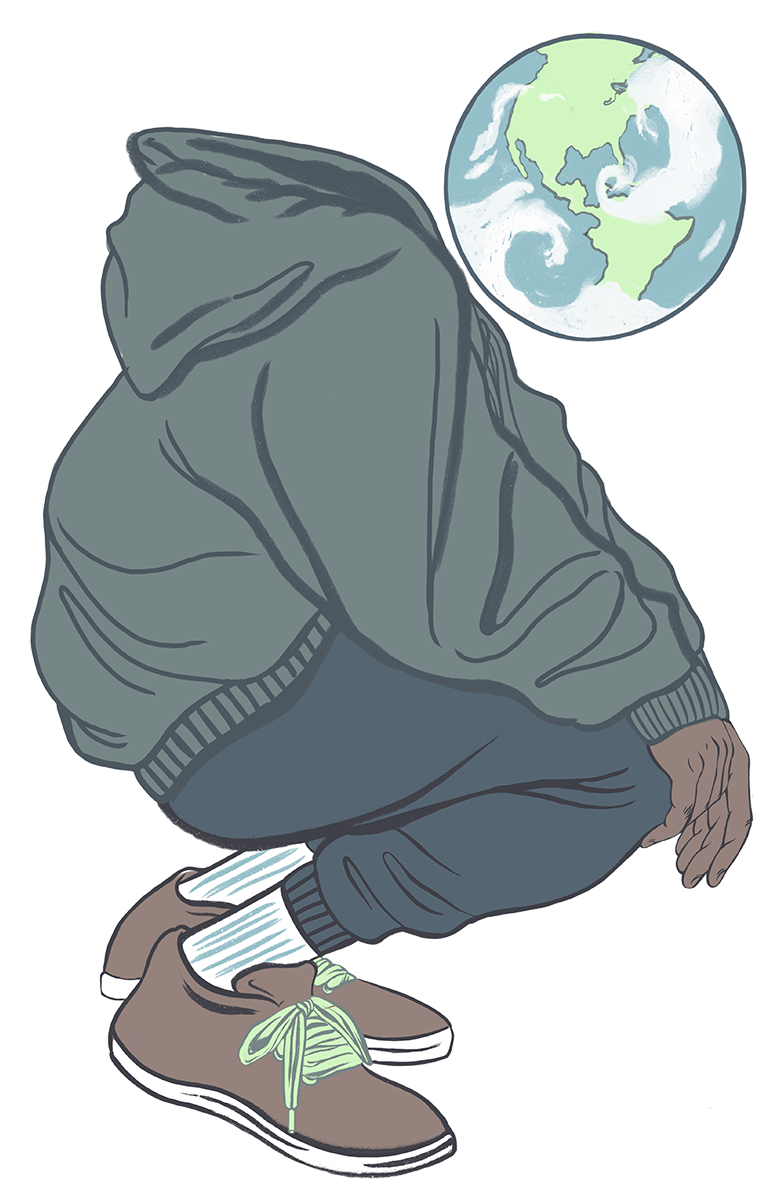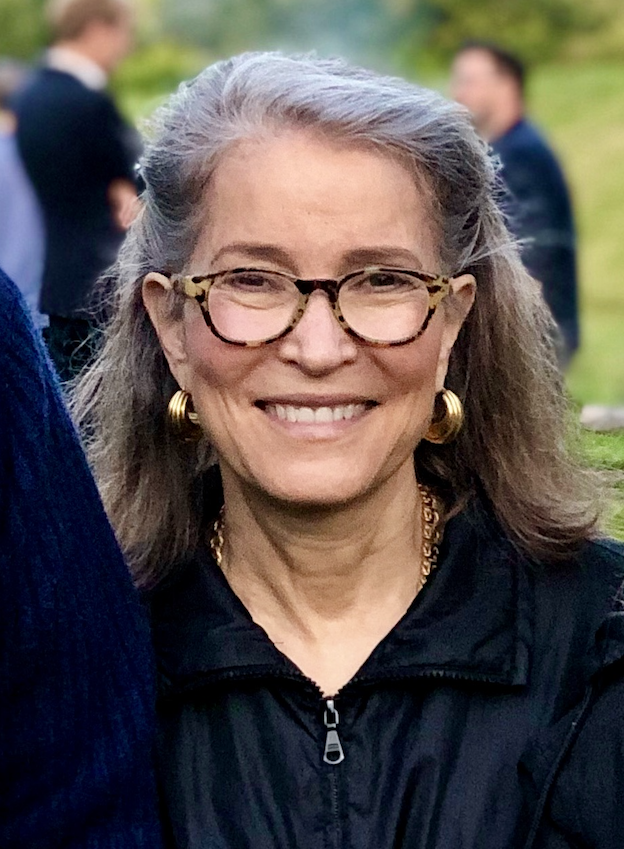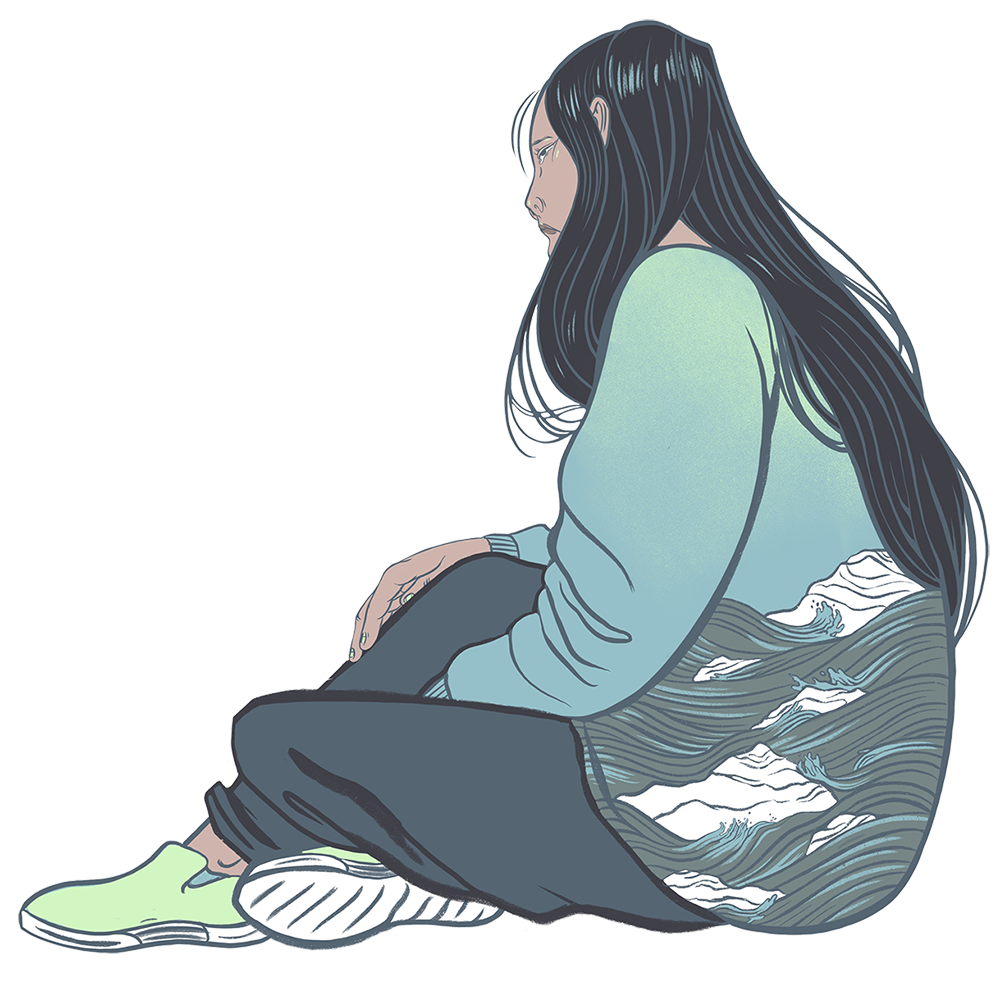
Meet the Woman Who Named Our Environmental Angst
The psychiatrist who coined the term “climate-linked, pre-traumatic stress” to refer to our anxiety regarding the environment talks about the origins of this condition, how to combat it, and why you should reconsider not having children just because the earth is a dumpster fire.
By Claire Miller
Illustrations by Katie Mulligan
2019 delivered yet another bad year for the planet. Hurricane Dorian, the second most powerful Atlantic hurricane on record, destroyed the Bahamas and caused $3.4 billion in damage. Australia faced the hottest year on record as fires raged through over 12 million acres, killing at least 21 people and an estimated one billion animals, including 25,000 koalas. The second wettest year in U.S. history cost more than $20 million in flood damage. Meanwhile, California also burned. In fact, July served as the hottest month in human history, with record heat waves claiming the lives of 1,500 people in France. And in August, Iceland held a memorial for Okjökull, the country’s first glacier to melt and disappear. Mourners laid a plaque in its place that read: “A letter to the future.”
The COVID-19 pandemic delivered a new danger and corresponding anxiety, and along with those anxieties, the globe’s environmental health continues to send us signs of its distress. Climate change also promises to trigger similar devastating impacts on society similar to the virus. The world has warmed nearly one degree centigrade above pre-industrial levels due to human emissions such as carbon dioxide. According to NASA, most of that warming took place in the last 35 years and has accelerated in more recent years. One degree centigrade might not sound like much, but it’s close to a catastrophic tipping point. According to the Intergovernmental Panel on Climate Change (IPCC), the most harmful and irreversible impacts of climate change will strike when we reach 1.5 degrees centigrade, and “rapid and far reaching” transitions will be necessary to keep global warming below that point. Regardless of whether those transitions are made, NASA officials predict the following events will take place in this century. Temperatures will keep rising. Heavy precipitation events, droughts, heat waves, and hurricanes will become more intense and frequent. The sea level will rise by one to four feet by the year 2100 and increase in acidification. And the arctic will be ice-free during summertime by mid-century.
In the meantime, say goodbye to the polar bears, bees, and butterflies.
The future effects of climate change, regardless of actions taken today, are what Colin Beier, associate professor at SUNY College of Environmental Science and Forestry, sees as pretty much guaranteed. “It’s kind of baked into the pie,” Beier, who studies environmental restoration and climate legislation, says. “Even if we stopped all greenhouse gas emissions tomorrow, we’ve affected the earth system enough that there are going to be some significant shifts in climate. Just like we can see how something like this virus pandemic touches every sector of our global economy and has this ripple effect, climate change is expected to have similar kinds of effects but potentially magnified. And there will be beneficiaries. There will be winners and losers from climate change.”
“Just like we can see how something like this virus pandemic touches every sector of our global economy and has this ripple effect, climate change is expected to have similar kinds of effects but potentially magnified.”
Contemplating the century ahead is anxiety provoking — particularly for Millennials and Gen Z. A November 2019 climate change survey from the Kaiser Family Foundation and the Washington Post shows that 57% of teenagers say climate change makes them afraid, and four in 10 say they feel helpless. But more than half of them also say it motivates them. Leaders from those younger generations are mobilizing to fight environmental issues and earning much attention for their work. Leading organizations like the Sunrise Movement and activists such as two-time Nobel-Prize nominee and Time person of the year Greta Thunberg, co-executive director of the US Youth Climate Strike Isra Hirsi, and human-rights activity and climate organizer with This Is Zero Hour, Elsa Mengistu, have led the movement for change.
Many young people share these leaders’ concern for our planet and for our future. In fact, the worry and anxiety regarding our globe’s health has entered into the lexicon of psychology professionals who have a name for that condition. Dr. Lise Van Susteren, a psychiatrist with a private practice in Washington D.C. started calling it “climate-linked, pre-traumatic stress.” After her U.S. Senate race 15 years ago, she realized she suffered from the condition herself. She’d look at a picture of a Caribbean island or a soaring bird, and all she’d think of was ocean acidification or extinction. “Rather than exclusively being grief stricken or anxious about the traumas that we were experiencing, like increased intensity and frequency of extreme weather events, I was also exceedingly conscious and overridden by what was going to happen in the future,” Van Susteren says.
The mere thought of climate change is driving people across all age groups to experience traumatic stress before the worst has even arrived. But for college students and younger generations who will be alive mid-century and beyond, Van Susteren says, there’s even more to it. While we’re stressed about the environment, we’re also experiencing intergenerational injustice and aggression. This is due to the past and current climate-killing actions of older generations and their unwillingness to execute systemic change for the sake of our futures. That injustice is part of what motivated a group of youths to sue the United States government back in 2015 in a case known as Juliana v. U.S., which claims that the government’s affirmative actions that cause climate change have violated their rights to life, liberty, and property. Van Susteren still serves in that ongoing case as an expert witness.
6 Reasons to be Hopeful About the Environment
1. Your Vote Matters. Despite the noise Trump made about pulling out of the Paris Agreement, the U.S. remains in it until the end of 2020. So, the upcoming election likely determines if we remain part of that global effort to fight climate change.
2. States Are Stepping Up. Despite that high-profile exit, 25 states, including California, New York, and Illinois stepped up to pursue the Paris Agreement targets by forming the U.S. Climate Alliance. These states represent 55% of America’s population and an $11.7 trillion economy.
3. Green Advocates Remain. Mid-level people still exist in the State Department who fund climate-related programs such as REDD+, which works to reduce emissions from deforestation and forest degradation in developing countries, says Associate Professor Colin Beier of SUNY College of Environmental Science and Forestry.
4. United By Crisis. “My guess is that if Clinton had won the election in 2016, we would not have seen this Climate Alliance emerge as a kind of protest to the dialogue coming out of the White House about this being a hoax,” Beier says. “And so it’s possible that there’s progress that is being made at the state level that might not have been made otherwise, despite the frustrations that many have at the federal level.”
5. Carbon-Neutral Progress. Beier teaches forest ecology at SUNY ESF, but he also runs a seminar that examines New York State’s new climate leadership and community protection act, which aims an 85% reduction in greenhouse gas emissions by 2050 and the ultimate goal of a carbon-neutral economy, which means the state would store as much CO2 as it emits. Beier sees forward momentum like this as a cause for hope.
6. Good Stewardship Can Create Change. Beier often points to environmental success stories such as the Clean Air Act, which reduced acid rain levels in the Adirondacks to pre-industrial revolution levels within 30 years. These achievements remind students they can participate in good science, influence good policies, and see real outcomes within their lifetimes. “We have to try to tell some stories that we humans are capable of making rapid and irreversible changes to this planet, but we’re also capable of really good stewardship,” Beier says. “Otherwise, we probably wouldn’t exist as a species.”
The 61% Project spoke to Dr. Van Susteren to learn more about climate-linked, pre-traumatic stress and how to cope with its effects on mental health.
The 61% Project: Climate change is a polarizing issue. Can you explain some of the psychology behind how people are reacting to our current political and physical environment?
Dr. Lise Van Susteren: If you don’t have a traumatic reaction to what is being said about what’s happening to the world, you’re not listening. The real pathological entity now, far from being pre-traumatic stress reaction or condition, is really climate disavowal disorder, CDD. It’s people who downplay, disavow, outright deny or disconnect from what is currently happening to the planet and what is predicted by climate scientists to happen in the future. Being unconcerned, callus, or disregarding the whole tableau of woes that awaits life on the planet — boy, that doesn’t say much for us as humans and certainly not for us with our much-vaunted sense of being empathic individuals. So there’s something missing in us when we fail to show compassion for the future generation, and we call this, of course, a condition of intergenerational injustice.
And it’s obviously got young people outraged, in despair, some of them cynical, some of them becoming paralyzed and giving up. But, there are many others who are rising to the challenge and they will continue, but older generations have engaged in trashing the planet, and rather than holding themselves accountable and making those changes, we are simply saying, you deal with it.
61%: How does climate-linked pre-traumatic stress impact students?

Dr. Lise Van Susteren, a psychiatrist with a private practice in Washington D.C., says she created a name for the worry and anxiety for our globe’s health after struggling herself to look at a picture of a soaring bird or tropical island without thinking of ocean acidification or extinction. Photo courtesy of Dr. Van Susteren.
L.V.S.: It’s huge. Young people realize that though they have contributed little to the problem, they will be suffering most of the consequences. And they rightly experience this, frankly, as a form of aggression, which it is. When you intentionally inflict harm on people, that’s aggression. And whether we admit it or not, the act of continuing to poison the planet so that future generations either are not able to survive or have to pick up the pieces is an act of aggression. So students are rightly upset about it. They’re anxious about their future, which they have heard is going to be deeply compromised, if it’s even survivable. And they are grief-stricken at the losses. And so their outrage is fully understandable, and it is a public health issue. I’m hearing campuses, teachers, professors reaching out to me who are asking about what to do with what has become an epidemic on campuses, and I can well understand all of the feelings that they have.
The question becomes, how do you build resilience? Unless the federal government takes action — and right now, it’s not only not taking action, it’s actively increasing our vulnerability by rolling back regulations and subsidizing the fossil fuel industry and promoting additional exploration — we’re not going to be able to take action in time. Right now, we are obviously in the midst of an administration that denies it’s very existence. So you know, do the math.
61%: And what is the current math? How much time do we have to turn things around?
L.V.S.: It’s really a question of how quickly we reach those tipping points and what that temperature is. Here’s what we do know: everything is happening faster than has been predicted. I know that the National Climate Assessment, and maybe even the IPCC which is a very, very conservative document, have said we’ve got another 10 years. Well, let’s hope so. But we don’t really know. It’s by the hour. Every chance not taken to either lower our emissions or reduce our emissions through our own behavioral changes and to draw down carbon, is an opportunity lost. We’re in a race against time now.
61%: So in that race against time, what do you do to combat the negative impacts on your mental health?
L.V.S.: O.K., I say the three Ps. The first P, personal action. Personally, I get very frustrated with people who say that our personal action doesn’t matter, of course personal action matters. What we do is certainly individual when we take personal action to reduce our carbon footprint. And that’s the first thing to do — go and calculate your personal carbon footprint.
But our actions are counted collectively, just like the votes in November. Yes, we only cast one vote, but they’re counted collectively. That’s how the culture changes. We drive markets with the purchases that we make collectively. So, if we’re all buying hybrid cars or we’re all taking mass transit, and we’ve all stopped taking airplanes and we’re taking trains, these are all actions that, collectively, change the culture. The people around us, our friends, our family, see the choices we’re making and are influenced by them.

The second thing is, professionally, what have you done at your workplace to be making sure that we are energy efficient, making sure that we are doing things that our colleagues see us doing, insisting that the administration take all actions to make the institution more sustainable?
And that goes for any place where you work. If you’re at a college, you should be demanding that your college divest from fossil fuels and look up all the names of other colleges that have divested from fossil fuels. If you’re a bank, insist that your bank not invest or lend money to fossil fuel industries. If you’re in another company, insist that it has a sustainability program.
Remember that everything you do is seen by other people, so pretty soon, it becomes the social norm. In other words, it’s trending. It becomes what is expected. Just like you get in a car and you buckle up, you don’t smoke a cigarette and blow smoke in a person’s face, and you practice safe sex, these are all things that we do that not doing them risks intense social disapproval. And though we suggest in surveys that we are more responsive to our own individual codes of action and not to what society is doing, every study shows that in fact what we’re most influenced by with the herd mentality is what the people around us are doing.
And then politically. These are the people who make the upstream decisions. Supporting candidates who are doing the right thing is critical. Bird-dogging candidates, asking the right questions, insisting on policies, showing up for protests in public places. These are all things that we can do personally and collectively.
61%: So those actions contribute to the environment and to personal mental health?
L.V.S.: Yes, everything that we do personally and collectively is a way for us to confront our own anxiety and not just stand there, but go from being a bystander to an upstander, which reduces our anxiety. We’ve all had the test we weren’t studying for. We’ve all had the paper we didn’t prepare. All of us try to put off and bury anxiety, or we think we’re putting it out of our minds, but all we really do is bury it. It’s really by confronting what’s causing our anxiety and unpacking it and taking action against it that we reduce it. Not by trying to shove it out of our consciousness, which we can’t do anyway.
61%: And what do you say to young people who aren’t sure they should have kids because of the environment and the future we face?
L.V.S.: What I tell people is this: if you are caring about climate, talking the way you do, we need good people on the planet. And the idea that you would make a free choice not to have children is fine, but we need good people on the planet, and I encourage the people who say these things to me to think about that. That we need good people on the planet to work hard for all the things that we’re working for. And that your child is likely to be a person like that, who is fighting for what we need. And the fight’s not going to be over anytime soon.
Resources
Consider putting your concern for the planet to work through engagement with these organizations: The Sunrise Movement is a youth led organization fighting climate change and working to create millions of jobs rooted in environmental action. #FridaysForFuture is the hashtag for the school strike for the climate that Greta Thunburg started in 2018. Students around the globe now use this to organize similar strikes on Fridays, and adults have joined them by protesting outside government buildings on those designated days.
Consider donating to these organizations: The Coalition for Rainforest Nations helps governments and communities responsibly manage their rainforests. Coalition members launched the United Nation’s REDD+ mechanism in 2005, which works to reduce emissions from deforestation and forest degradation. Call (646) 448-6870 for more informaiton or email info@rainforestcoalition.org.
The Clean Air Task Force is a group working to push changes in technologies and policies in order to achieve zero-emissions energy, waste, agricultural, and forest management systems by 2050. Call 617-624-0234 or email info@catf.us.
View a complete list of resources.
